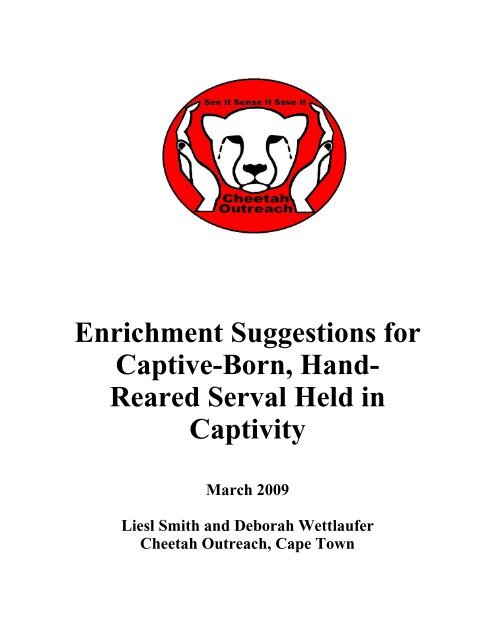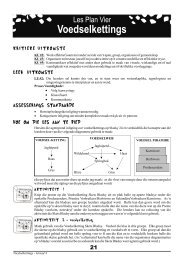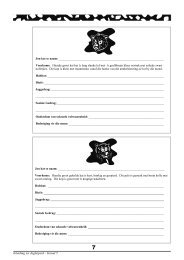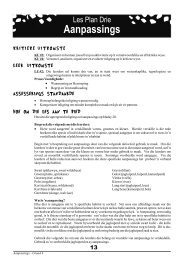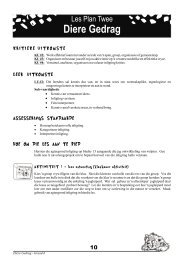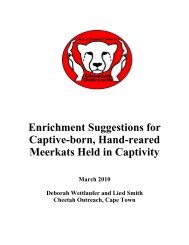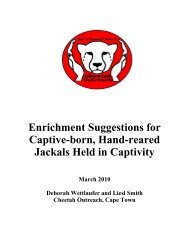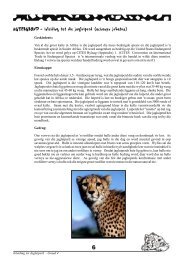Enrichment Suggestions for Captive-Born, Hand- Reared Serval ...
Enrichment Suggestions for Captive-Born, Hand- Reared Serval ...
Enrichment Suggestions for Captive-Born, Hand- Reared Serval ...
You also want an ePaper? Increase the reach of your titles
YUMPU automatically turns print PDFs into web optimized ePapers that Google loves.
<strong>Enrichment</strong> <strong>Suggestions</strong> <strong>for</strong><br />
<strong>Captive</strong>-<strong>Born</strong>, <strong>Hand</strong>-<br />
<strong>Reared</strong> <strong>Serval</strong> Held in<br />
Captivity<br />
March 2009<br />
Liesl Smith and Deborah Wettlaufer<br />
Cheetah Outreach, Cape Town
<strong>Enrichment</strong><br />
Animals in captivity have a lot of time on their hands. Whereas wild animals would fill<br />
their time with activities such as hunting, searching <strong>for</strong> water or shelter, protecting their<br />
territory or searching <strong>for</strong> a mate, captive animals very often are provided all of these.<br />
This could potentially create problems such as boredom, frustration, stereotypic<br />
behaviors and stress. Undesirable behaviours include self-injurious actions like excessive<br />
grooming; abnormal behaviours such as regurgitation and reingestion; aggressive<br />
behaviours; and stereotypic behaviours. Behaviour is an important indication of welfare<br />
and enrichment enhances welfare of animals in captivity.<br />
<strong>Enrichment</strong> becomes a valuable and necessary practice by creating activities or providing<br />
stimulation that maximizes their quality of life and leads to inquisitive behavior.<br />
By enriching the animal’s environment, you empower the animal to have control over its<br />
environment and you give the animal a choice. Ignoring something is still a choice.<br />
Apart from the fact that enrichment provides methods of passing time, the added physical<br />
and mental stimulation might also cause better reproductive success and improve visitor’s<br />
experiences since the image of healthy and well-adjusted animals are promoted.<br />
Different <strong>for</strong>ms of enrichment used <strong>for</strong> captive animals today include:<br />
Enclosure Design<br />
Feeding or <strong>for</strong>aging<br />
Visual and Auditory<br />
Olfactory<br />
Novel Objects and Toys<br />
Exercise<br />
Social Interaction/Tactile<br />
Behavioural Conditioning<br />
<strong>Enrichment</strong> should be considered part of the daily husbandry routine at all responsible<br />
animal care facilities. An efficient enrichment programme can be more important than the<br />
size of the enclosures the animals are kept in. Environmental enrichment is not a luxury<br />
but a management tool.<br />
When developing an enrichment programme at a captive facility, the habits, behaviours<br />
and nature of the species, and the personality of the specific individual need to be<br />
considered.<br />
<strong>Enrichment</strong> suggestions <strong>for</strong> the serval include the following:<br />
Produced by Cheetah Outreach (Last Updated: February 2013)<br />
cheetah@intekom.co.za Http://www.cheetah.co.za<br />
Homes Provided by Heartland and Eikendal<br />
2
Enclosure Design<br />
Enclosures should be designed in order to address the needs <strong>for</strong> space, shade, shelter,<br />
privacy, stimulation, elevation and where appropriate, public viewing.<br />
When designing enclosure layouts the following should be incorporated:<br />
Shade<br />
Structures providing shade is an essential element in every enclosure.<br />
Shelter<br />
Waterproof huts not only serve as sleeping quarters and as hideaway, but also provide a<br />
lookout post to the animal.<br />
Produced by Cheetah Outreach (Last Updated: February 2013)<br />
cheetah@intekom.co.za Http://www.cheetah.co.za<br />
Homes Provided by Heartland and Eikendal<br />
3
Water<br />
Water should be provided in solid, non-toxic containers. Containers should be placed in<br />
an easily accessible and shaded area. All water containers should be disinfected on a<br />
regular basis and the same container used <strong>for</strong> the same cat preferably.<br />
Logs<br />
Big logs can be packed at angles to one another. Alternatively flat pieces of logs can be<br />
stacked loosely on top of and against one another. Logs provide an often-visited area to<br />
many cats. The servals at Cheetah Outreach often jump on the logs to get a better view<br />
of the surrounding area and also enjoy sharpening claws on them.<br />
Vegetation<br />
In the wild servals are found in grasslands and often in reed beds on the edges of rivers<br />
and swamps. They use the cover to hunt and hide away from threats. In captivity it is<br />
important to provide enough vegetation and cover in the enclosure. This can be offered<br />
in the <strong>for</strong>m of shrubs or sections of long grass.<br />
Produced by Cheetah Outreach (Last Updated: February 2013)<br />
cheetah@intekom.co.za Http://www.cheetah.co.za<br />
Homes Provided by Heartland and Eikendal<br />
4
Water Features<br />
<strong>Serval</strong>s are often found near permanent water sources and many enjoy spending some<br />
time in water. Water features can be incorporated into the enclosure, but the design<br />
should allow <strong>for</strong> regular and proper cleaning. If this is not possible water can be<br />
provided by using big, shallow water containers or pools. The serval at Cheetah<br />
Outreach has often been seen lying in the water in a pool on warm summer days.<br />
Jumping Plat<strong>for</strong>m<br />
When planning to build a plat<strong>for</strong>m the following should be considered:<br />
1. Materials used<br />
Non-toxic, safe materials should be used.<br />
2. Placement<br />
The plat<strong>for</strong>m should be placed in such a position as not to allow any jumping or climbing<br />
over fences or other structures. The plat<strong>for</strong>ms are all erected on a flat, open section of<br />
grass, well away from any fences, huts or any other structure.<br />
3. Construction<br />
There should be no protruding or sharp objects. There should be no objects that could<br />
cut, injure or get the animal entangled.<br />
To accommodate the development of the serval’s jumping ability, it is a good idea to<br />
construct a plat<strong>for</strong>m with an adjustable height mechanism. In this way it can gradually be<br />
lifted higher as the serval develops and attempts higher jumps.<br />
Produced by Cheetah Outreach (Last Updated: February 2013)<br />
cheetah@intekom.co.za Http://www.cheetah.co.za<br />
Homes Provided by Heartland and Eikendal<br />
5
Privacy<br />
Concealed, private areas should be provided in all serval enclosures. Rocks, areas of<br />
shade cloth, palm fronds, reeds or simple bamboo walls can be used to provide these.<br />
Security<br />
<strong>Serval</strong> enclosures should be roofed to prevent escape.<br />
Vertical Space<br />
The enclosure should offer vertical space to accommodate jumping and climbing<br />
behaviour. This can be provided with sloping branches, poles and plat<strong>for</strong>ms.<br />
Produced by Cheetah Outreach (Last Updated: February 2013)<br />
cheetah@intekom.co.za Http://www.cheetah.co.za<br />
Homes Provided by Heartland and Eikendal<br />
6
Manipulating enclosure layout<br />
Gates separating adjacent enclosures might be opened and provides more space and<br />
opportunities <strong>for</strong> enrichment.<br />
Habitat Modifications<br />
Habitat modification by moving and changing exhibits inside the enclosures might<br />
provide stimulation.<br />
Feeding<br />
Elevating Food<br />
Food can be placed in a tree or other elevated areas. This encourages the serval to jump<br />
or climb <strong>for</strong> his food.<br />
Produced by Cheetah Outreach (Last Updated: February 2013)<br />
cheetah@intekom.co.za Http://www.cheetah.co.za<br />
Homes Provided by Heartland and Eikendal<br />
7
Bungee Feeder<br />
Hanging a large bone with meat from a bungee cord prolongs feeding by encouraging the<br />
serval to grab, hold, pull, rip and try to drag away the attached food. A bone attached to<br />
the bungee feeder causes much excitement and will stimulate the serval to jump, leap and<br />
stand on hind legs to get at the bone.<br />
Plastic Tube<br />
Food offered in a long plastic tube encourages natural hunting behaviour by encouraging<br />
the serval to grab <strong>for</strong> its food as it would grab rodents from their burrows in the wild.<br />
Produced by Cheetah Outreach (Last Updated: February 2013)<br />
cheetah@intekom.co.za Http://www.cheetah.co.za<br />
Homes Provided by Heartland and Eikendal<br />
8
Raw Fish in Water<br />
Offering pieces of raw fish in a pool of water combines natural prey with a serval’s love<br />
of water and encourages natural hunting behaviour. <strong>Serval</strong>s will use their paws to scoop<br />
bits of fish out and continue to return to the water until all small bits are gone.<br />
Whole or Partial Birds with Feathers<br />
In the wild servals take birds up to the size of flamingos and storks on a regular basis.<br />
Feeding with feathers encourages natural stalking and jumping behaviour as well as<br />
tossing of dead birds and plucking of feathers be<strong>for</strong>e eating. Feeding should be<br />
supervised and remnants from the carcass removed. The origin and health status of the<br />
bird offered should be known.<br />
Produced by Cheetah Outreach (Last Updated: February 2013)<br />
cheetah@intekom.co.za Http://www.cheetah.co.za<br />
Homes Provided by Heartland and Eikendal<br />
9
Day-old Chicks<br />
Dead baby chicks can supplement normal diet and add enrichment by throwing or<br />
hanging <strong>for</strong> a serval. Chicks should be de-yolked prior to feeding.<br />
Carcasses<br />
Whole carcasses can provide hours of stimulation. A variety of stalking, hunting and<br />
feeding behavior may be observed when offering whole or partial carcasses.<br />
The origin and health status of the animal offered should be known and the session<br />
supervised.<br />
Whole Rats and Mice<br />
When available, whole rats and mice can be given (guts should be removed). Apart from<br />
providing roughage, whole carcasses provide much stimulation, encouraging natural<br />
hunting and eating behaviour, such as pouncing, tossing prey, licking and plucking fur.<br />
Whole carcasses also increase the length of feeding activity.<br />
Produced by Cheetah Outreach (Last Updated: February 2013)<br />
cheetah@intekom.co.za Http://www.cheetah.co.za<br />
Homes Provided by Heartland and Eikendal<br />
10
Meat with Fur<br />
Sections of horsemeat and rabbit with fur can be given. Apart from providing roughage,<br />
meat with fur also changes the texture of the food and increases the length of feeding<br />
activity.<br />
Bones<br />
Big bones can be provided to chew on. Whenever the serval at Cheetah Outreach is<br />
presented with a big horse bone, he spends considerable time rubbing his neck and<br />
cheeks up against it.<br />
Produced by Cheetah Outreach (Last Updated: February 2013)<br />
cheetah@intekom.co.za Http://www.cheetah.co.za<br />
Homes Provided by Heartland and Eikendal<br />
11
Bloodsicles<br />
These are made by freezing blood and a few pieces of meat in small plastic containers,<br />
and can be offered on warm days.<br />
Raw Eggs<br />
<strong>Serval</strong>s would naturally eat eggs of ground-nesting birds in the wild and the ones at<br />
Cheetah Outreach love raw eggs. Once a small hole is cracked open in the shell, they<br />
will lick all the contents out and continue to lick the ground around the egg to get any that<br />
has spilled out.<br />
Visual and Auditory<br />
Objects that provide visual and auditory stimulation include the following:<br />
Outside Stimuli<br />
Outside stimuli includes passing trains, motorbikes, running children, other animals,<br />
laborers, bicycles and wheelchairs. Having visual access to some of these not only<br />
provides mental stimulation, but can also provide good exercise since some animals will<br />
chase some of these objects and show much interest<br />
Other Animals<br />
Walking different types of animals on their leads past the serval enclosure or walking the<br />
serval past their enclosures provides much interest and stimulation. The serval typically<br />
follows the animal along the fence, tries to sniff it through the fence or hisses at it. Often<br />
this is associated with vocalization and posturing. Animals at Cheetah Outreach that<br />
provide visual and auditory stimulation by close proximity are dogs, cheetahs, caracal,<br />
jackals, bat-eared foxes and meerkats. Be careful not to allow the animal too close to the<br />
fence, since the serval may try to grab the animal through the fence.<br />
Produced by Cheetah Outreach (Last Updated: February 2013)<br />
cheetah@intekom.co.za Http://www.cheetah.co.za<br />
Homes Provided by Heartland and Eikendal<br />
12
Adjacent enclosures containing dogs, bat-eared foxes, other serval and caracal also<br />
provide much stimulation <strong>for</strong> the servals at Cheetah Outreach.<br />
Olfactory<br />
Moving Animals between Enclosures<br />
The serval can be moved into a <strong>for</strong>eign or lesser-known enclosure. It is important that<br />
the enclosure has a fenced roof to prevent escape. If this is not possible the animal<br />
should be walked on a lead and collar. Intense sniffing and investigating may be<br />
observed.<br />
Moving Objects between Enclosures.<br />
Some of the exhibits can be moved from one enclosure to another. The health status of<br />
all animals should always be known. Objects should never be moved from a sick or<br />
compromised animal to the enclosure of a healthy one.<br />
Providing Scents<br />
Scents can be provided by using spices such as cinnamon, chili powder and ginger.<br />
Lavender is not seen as a viable herb to use, since it has been known to contain secondary<br />
plant compounds that might cause mild toxicity. Perfumes or lotions can provide<br />
stimulation. Scented items should only be given in open, airy areas to provide adequate<br />
ventilation.<br />
Fresh catmint has provided much stimulation to the servals at Cheetah Outreach,<br />
resulting in much rolling, rubbing and chewing on it.<br />
Novel Objects and Toys<br />
Toys encourage servals to play and release pent-up energy. Some toys will encourage<br />
natural behaviours such as stalking, running, jumping in the air, pouncing, carrying<br />
objects around in mouths and kicking objects as they would dead prey. <strong>Serval</strong>s are<br />
natural athletes, chasing toys at high speed and leaping high in the air <strong>for</strong> objects.<br />
Toys and novel objects should never be left unsupervised with animals.<br />
Soft, Rubber and Rope Toys<br />
When choosing objects <strong>for</strong> animals to play with, care should be taken that these objects<br />
are non-toxic and preferably organic in nature. Inside stuffing as well as solid objects<br />
such as button eyes should be removed be<strong>for</strong>e allowing the animal to play with a toy.<br />
Favourite toys <strong>for</strong> servals include fluffy toys, balls, rubber snakes and small mouse toys.<br />
They also respond well to any toy that has feathers attached.<br />
Produced by Cheetah Outreach (Last Updated: February 2013)<br />
cheetah@intekom.co.za Http://www.cheetah.co.za<br />
Homes Provided by Heartland and Eikendal<br />
13
Balls<br />
<strong>Serval</strong>s respond well to balls. They can either be thrown with a rolling motion <strong>for</strong> the<br />
servals to chase after or placed in a big plastic container from which they can try and<br />
retrieve it. Another idea is to place the ball on the inside groove of a tyre that is lying flat<br />
on the ground. If the ball is made to roll fast, the sound and movement and the difficulty<br />
in retrieving the ball can keep the serval occupied <strong>for</strong> a long time.<br />
Plastic Bottles<br />
These can be offered loose or attached to a whip toy to chase after.<br />
Produced by Cheetah Outreach (Last Updated: February 2013)<br />
cheetah@intekom.co.za Http://www.cheetah.co.za<br />
Homes Provided by Heartland and Eikendal<br />
14
Feathers<br />
<strong>Serval</strong>s react strongly to feathers since birds are a favourite prey in the wild. Guinea fowl<br />
wings or bundles of feathers can be attached to a whip to encourage chasing and jumping,<br />
or thrown to be played with. It is imperative to make sure these are disease- and parasitefree.<br />
This can be done by freezing, washing, microwaving or leaving the objects in the<br />
sun.<br />
Produced by Cheetah Outreach (Last Updated: February 2013)<br />
cheetah@intekom.co.za Http://www.cheetah.co.za<br />
Homes Provided by Heartland and Eikendal<br />
15
Splash Pools<br />
These can be filled with water and offered to the serval as a place to cool down.<br />
Alternatively toys can be placed inside <strong>for</strong> the serval to retrieve.<br />
Cardboard Boxes<br />
Cardboard boxes offer an ideal place <strong>for</strong> a serval to hide. Toys can alternatively be<br />
placed inside boxes <strong>for</strong> the serval to play with and retrieve. Any harmful substances such<br />
as staples or plastic tape should be removed first and servals should be carefully<br />
supervised while playing to make sure they do not eat and ingest part of the cardboard.<br />
Bags Filled with Leaves<br />
Hanging a plastic bag filled with leaves provides much entertainment and exercise <strong>for</strong> a<br />
serval, and encourages jumping, grabbing, sniffing and batting at the object until the bag<br />
is ripped open and the leaves fall out.<br />
Produced by Cheetah Outreach (Last Updated: February 2013)<br />
cheetah@intekom.co.za Http://www.cheetah.co.za<br />
Homes Provided by Heartland and Eikendal<br />
16
Exercise<br />
Exercise is an essential part of husbandry that cannot be compromised on. Not only does<br />
the activity help to maintain a healthy physical condition, but it also provides excellent<br />
mental stimulation. Exercise can be provided by the following means:<br />
Toys<br />
Balls and rubber snakes are some of the servals’ favourite toys. Rubber snakes can be<br />
suspended from an elevated area to encourage the serval to jump up and retrieve. Balls<br />
can be thrown to encourage the serval to run and leap in the air.<br />
Produced by Cheetah Outreach (Last Updated: February 2013)<br />
cheetah@intekom.co.za Http://www.cheetah.co.za<br />
Homes Provided by Heartland and Eikendal<br />
17
Water<br />
<strong>Serval</strong>s can’t resist water and squirting it from a hosepipe will encourage the serval to<br />
chase after it and play with it.<br />
Whip with Novelty Item<br />
A novelty item can be attached to a whip or a piece of string tied to a long bamboo stick.<br />
These objects can be used to encourage jumping and chasing behavior. Feathers,<br />
colourful rags and fuzzy toys seem to attract the most attention from the servals at<br />
Cheetah Outreach. Even a whip with nothing attached will encourage the serval chase<br />
after it if it is wiggled in grass like a snake.<br />
Produced by Cheetah Outreach (Last Updated: February 2013)<br />
cheetah@intekom.co.za Http://www.cheetah.co.za<br />
Homes Provided by Heartland and Eikendal<br />
18
Walks<br />
Walks can provide the handler with many opportunities to enrich a serval’s life. New and<br />
different environments can provide a variety of smells and sights to investigate and could<br />
offer hunting opportunities. The serval at Cheetah Outreach has been observed hunting<br />
small snakes, lizards, frogs and mice on these walking excursions. Walks also provide<br />
opportunities to interact with other animals.<br />
Social Interaction/Tactile<br />
Interaction with Staff/Volunteers<br />
For animals kept in captivity and thus exposed to people, it is to their benefit to view<br />
humans positively. This greatly minimizes one of the main stresses in captivity.<br />
Produced by Cheetah Outreach (Last Updated: February 2013)<br />
cheetah@intekom.co.za Http://www.cheetah.co.za<br />
Homes Provided by Heartland and Eikendal<br />
19
Interaction with Other Animals<br />
Seeing, smelling and interacting with other animals through a fence or at a distance can<br />
greatly enrich a captive serval’s life. This should be a positive experience <strong>for</strong> the animals<br />
and not lead to anxiety. Care should be taken to assess the demeanor and behaviour of all<br />
animals carefully.<br />
Interaction with the Public<br />
This could be by means of personal encounters at the facility, school visits, private<br />
functions, public events and photographic or film shoots. Individuals that work with the<br />
public should be selected carefully and must only include animals that are<br />
temperamentally suited to having interaction with the public.<br />
Produced by Cheetah Outreach (Last Updated: February 2013)<br />
cheetah@intekom.co.za Http://www.cheetah.co.za<br />
Homes Provided by Heartland and Eikendal<br />
20
Behavioral Conditioning<br />
Behavioral conditioning is very important since it provides mental stimulation and<br />
challenges cognitive skills. The level of conditioning depends on the individual animal<br />
and might be one or all of the following:<br />
Lead Walking<br />
Lead walking begins at an early age in order <strong>for</strong> young cats to get accustomed to the<br />
restricted feeling of harness or collar and lead. Lead walking is important <strong>for</strong> all<br />
ambassador cats.<br />
Produced by Cheetah Outreach (Last Updated: February 2013)<br />
cheetah@intekom.co.za Http://www.cheetah.co.za<br />
Homes Provided by Heartland and Eikendal<br />
21
Venue Conditioning<br />
Clicker Conditioning<br />
This type of conditioning is used to shape behavior by means of positive rein<strong>for</strong>cement.<br />
Use of a clicker can be extremely helpful in situations where you might have to<br />
manipulate the animal’s movements, such as on a film set. It is essential that the handler<br />
display a good sense of timing when using a clicker.<br />
Produced by Cheetah Outreach (Last Updated: February 2013)<br />
cheetah@intekom.co.za Http://www.cheetah.co.za<br />
Homes Provided by Heartland and Eikendal<br />
22
Transportation<br />
Crates may be used to transport animals to the vet or in the event of a fire or other<br />
emergency. Rein<strong>for</strong>cing familiarity with crates can be done by feeding inside the crate<br />
on a rotational basis. This will ensure that the animal does not harbor negative feelings<br />
toward the crate. This is very often the case since the crates are used to transport them to<br />
the vet and represent negative experiences. Crates should always be disinfected be<strong>for</strong>e<br />
being moved to a different enclosure. Crates will also be needed in the event of a fire and<br />
being able to load the animals quickly and without resistance might mean the difference<br />
between life and death. By increasing the length of time the animal stays in the crate you<br />
can train them to accept the crate as a safe place <strong>for</strong> flying, etc.<br />
Produced by Cheetah Outreach (Last Updated: February 2013)<br />
cheetah@intekom.co.za Http://www.cheetah.co.za<br />
Homes Provided by Heartland and Eikendal<br />
23


